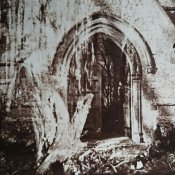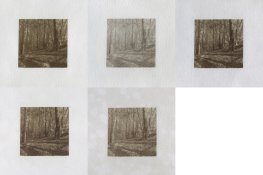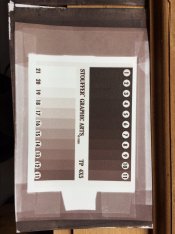Some more thoughts and experiences with this nice process ...
1. During September this year, I found that I was suddenly struggling to make a technically decent print. Contrast was down, sometimes quite remarkably so, and there were stains appearing in the first wash. Printing times were all over the place, despite the beautiful sunny (but humid) weather we were having.
When taking a print from the frame just as it looked nicely cooked, and putting it into an mildly acidic wash produced almost no "development", and prints started to bleach away rather than intensifying in the fixer.
Exchanging notes with Ned via PM, we agreed that humidity might be the culprit, and as the end of the month rolled by and the humidity fell, I again was able to make good prints.
Yesterday I coated some paper and let it dry overnight. It seemed slightly (barely noticeably) "tacky" to the touch this morning, but nevertheless I made (or tried to make) three prints using my normal processing sequence, and all of them exhibited very low contrast, underdevelopment, stains, fogging and general lassitude.
So I've been thinking again about humidity and why this might be a problem. And my eye is drawn to the following few sentences from Namias' original paper:
... in the washing, which should take place immediately after printing, there is a further reduction of the silver citrate, which brings about a great increase in the vigor of the print. Exposure to light alone can never bring about this reaction between the ferrous salt and the silver citrate, on account of the absence of sufficient moisture in the sensitive paper to act as the vehicle by means of which the two salts are brought together. This washing may therefore be regarded as a partial development -- the ferrous citrate being completely restored to its condition of ferric citrate by reducing the silver salt to metallic silver.
Now, bearing those words in mind -- and also bearing in mind that I am almost entirely a chemistry ignoramus, and that I can easily get hold of the wrong end of the stick about things I only very partially understand -- I could infer from the above that a coated paper that is not entirely dry will undergo all or much of the reduction
before going into the wash, and that this might indicate why my papers were not developing in the wash.
All speculation as to the whys and wherefores aside, it does seem - purely from my own experience and testing - that coated paper must be parchment-dry at the point of exposure. It doesn't seem to matter if the paper is dried, then gains moisture again (from ambient humidity) and is then dried fully again, but it must be fully dry when exposed.
2. Fixing in hypo. Ned speculated a bit in a post above about "ripened" hypo to produce the richest image colour, but having made several dozens of prints now, I'm inclined to suggest the opposite.
Prints of mine that show the richest colour and most definite colour change in the fixer are always those that go into freshly made fixer. I cannot begin to suggest why this should be from the chemistry point of view, because I know nuffink.
Namias speculates on the reason for colour change in the fixer as follows:
... I am inclined to attribute this to a slight sulphurization, facilitated probably by by traces of iron present in the image
I might also infer from that that a less fully washed image (and thus one retaining more iron) might show greater colour change, but then less perfectly washed images also run the risk of staining in the fixer due to too much iron, as we know from others' experience with kallitypes (if I remember correctly?)
My fixing regime has been to use 80g/l of Sodium thiosulfate (penta) with a rounded teaspoon of Sodium bicarbonate tossed in*. I've been fixing for about 90s in a single bath. Image colour definitely changes (weakens) after 3 or 4 10x8s. I'm now experimenting with a two-bath regime, using the same fixer recipe.
* The addition of bicarb to fixer is a hangover from when I was mostly doing salted-paper prints - a slightly alkaline fixer supposedly mitigating bleaching of the print. I tried carbonate in my Namias fixer but it didn't seem to produce such a good colour. I haven't tried borax, ammonia or potato water yet, but give me time.


 ) I might as well have a go at a "proper" VDB too!
) I might as well have a go at a "proper" VDB too! ) and the right subject, it might make for a lovely effect.
) and the right subject, it might make for a lovely effect.



